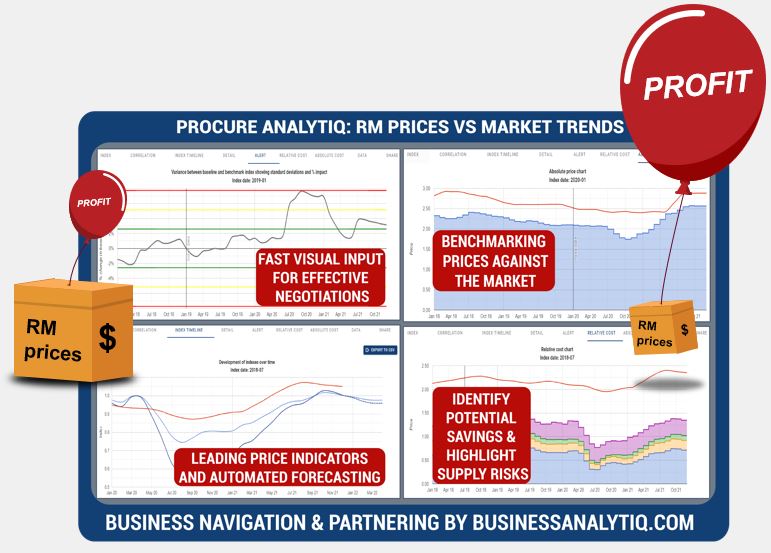Ammonium sulfate price April 2024 and outlook (see chart below)
- North America:US$0.26/KG, -3.7% down
- Europe:US$0.17/KG, -5.6% down
- Africa:US$0.21/KG, unchanged
- Northeast Asia:US$0.09/KG, unchanged
- South America:US$0.27/KG, unchanged
Business Analytiq assumes no responsibility or liability for any errors or omissions in the content of this site. The information contained in this site is provided on an “as is” basis with no guarantees of completeness, accuracy, usefulness, or timeliness.
Ammonium sulfate price index
This post is a summary of the ammonium sulfate price developments. The price developments of ammonium sulfate are expressed in US$ prices converted FX rates applicable at the time when the price was valid. Ammonium sulfate price index developments are calculated from multiple separate sources of data to ensure statistical accuracy.
The outlook for ammonium sulfate prices, on the second tab, is generated from different inputs including:
- Very recent price developments of immediate cost drivers of ammonium sulfate prices
- Recent price developments of underlying feedstocks which drive the price of ammonium sulfate
- Market futures for both cost drives and feedstocks of ammonium sulfate prices
- Adjustment of current supply/demand imbalances in the ammonium sulfate market
- Longer term trends in likely demand conditions
Further information on the Ammonium sulfate price index
What is ammonium sulfate
Ammonium sulfate is an inorganic compound that is composed of ammonia, sulfur, and oxygen atoms. It is a white, crystalline solid with a strong, sour smell. Ammonium sulfate is highly water-soluble and is often used as a fertilizer or a soil conditioner.
Ammonium sulfate is produced through the reaction of ammonia and sulfuric acid, which results in the formation of ammonium sulfate and water. The reaction is carried out at high temperatures and pressures, and the resulting product is then cooled and crystallized to produce the final product.
Ammonium sulfate is widely used as a fertilizer, as it provides plants with both nitrogen and sulfur, which are important nutrients for plant growth. It is also used as a soil conditioner, as it can improve the structure of soil and increase its ability to retain water. Ammonium sulfate is also used in the production of some pharmaceuticals and as a food additive. Overall, ammonium sulfate is an important chemical that is used in a variety of applications.
How is ammonium sulfate produced
Ammonium sulfate is produced through the reaction of ammonia and sulfuric acid, which results in the formation of ammonium sulfate and water. The specific process for producing ammonium sulfate involves the following steps:
Production of ammonia
Ammonia is produced through the reaction of nitrogen and hydrogen gas. Nitrogen is obtained from the air, while hydrogen is produced through the steam reforming of natural gas.
Production of sulfuric acid
Sulfuric acid is produced through the reaction of sulfur dioxide and oxygen with water.
Reaction of ammonia and sulfuric acid
The ammonia and sulfuric acid are then mixed and reacted to form ammonium sulfate and water. This reaction takes place at high temperatures and pressures.
Separation and purification
The ammonium sulfate is separated and purified through a series of steps, including filtration, crystallization, and drying.
Overall, the production of ammonium sulfate involves a series of chemical reactions and processes that convert raw materials into the final product. The specific process used depends on the availability of raw materials and the desired end product.
What is ammonium sulfate used for
Ammonium sulfate is a versatile chemical that is used in a variety of applications due to its unique properties. Some common uses of ammonium sulfate include:
Fertilizer
Ammonium sulfate is widely used as a fertilizer, as it provides plants with both nitrogen and sulfur, which are important nutrients for plant growth. It is commonly used on crops such as wheat, corn, and alfalfa.
Soil conditioner
Ammonium sulfate is used as a soil conditioner, as it can improve the structure of soil and increase its ability to retain water.
Production of pharmaceuticals
Ammonium sulfate is used in the production of some pharmaceuticals.
Food additive
Ammonium sulfate is used as a food additive to improve the texture and appearance of some products.
Overall, ammonium sulfate has a wide range of uses due to its ability to provide plants with important nutrients and its ability to improve the structure of soil. It is an important chemical that is used in a variety of applications.
How big is the ammonium sulfate market
It is difficult to estimate the size of the global ammonium sulfate market as a whole, as it is used in a variety of industries and applications. However, ammonium sulfate is an important chemical and is widely used in the production of a variety of products. According to some estimates, the global ammonium sulfate market was valued at around $5.5 billion in 2019 and is expected to grow at a compound annual growth rate of around 3.5% from 2020 to 2025. The growth of the ammonium sulfate market is driven by factors such as increasing demand for ammonium sulfate as a fertilizer, as well as growing demand for ammonium sulfate in the production of pharmaceuticals and as a food additive.
According to https://oec.world/ :
Ammonium sulphate, in packs >10 kg are the world’s 1225th most traded product.
In 2020, the top exporters of Ammonium sulphate, in packs >10 kg were China ($1.07B), Belgium ($171M), Canada ($110M), United States ($105M), and Netherlands ($102M).
In 2020, the top importers of Ammonium sulphate, in packs >10 kg were Brazil ($416M), United States ($174M), Indonesia ($125M), Vietnam ($121M), and Burma ($73.4M).
Further reading
Business Analytiq
BE THE FIRST TO SEE RISK AND OPPORTUNITY!
BusinessAnalytiq provides unlimited market trend data and an online tools to track market developments, key benchmarks & leading indicators.
BusinessAnalytiq leads to price visibility, better negotiations, easier budgeting and forecasting, lower raw material prices, and improved better internal and external communication. BusinessAnalytiq will decrease risk and higher profit.

Where does the data come from?
- The source of the data are exclusively public non-confidential sources. We have no access to primary data
- This the index trend of the price trend of the "product category" in general, and not a single specification of the product in particular
- The data is a combination of contract and spot pricing
- Our algorithms are set up to eliminate significant product mix impact on the reported price
- We combine public publications, import/export records, trading prices, company announcements, magazine articles, tweets, and other sources of ad-hoc public information.
- The chart shows the our best approximation of the market trend based on our algorithm interpretation of the signals
- For most indexes we have multiple sources and we focus on using statistically-correlated sources
- As a function of our automation, it is likely that recent trends will be adjusted as we discover more information. So, for example, the price trend for February 2024 will be first calculated in February 2024 and adjusted in March, April and May 2024.
- We will update the data trend as more information becomes available, and this means that recent trends will always be adjusted as we get more data available
- The algorithm will regularly revise our understanding of market trends, and indicated market trends may change
- The data is presented in US$. The UOM of measure is shown in the Index list table
- Our automated software and we do our best to create an accurate representation of the trend
Where does the data NOT come from?
- We do not purchase data from any other source and republish it.
- We will not purchase data from any other source and republish it
- We do not extrapolate trends, even for the forecast. We look for other market signals and leading indicators
What data should our company use?
- If you are making decisions driving significant share of profit, we always recommend that you buy data from the companies who invest in direct primary market access such as ICIS, amongst many others
- Our data, at best, represents an estimate of the market trend based on public information
- We have no direct access to the market, and we do not interview suppliers and customers
- Our automated analysis tools in the online software are set up to combine our data with other sources of data
- We do not recommend that you use our data for direct price mechanisms, as we may change and improve the data trends over time, including historical data
What does the quality indication in the main menu mean?
- Quality level A: Data is from a reliable and confirmed source
- Quality level B: Data is from multiple credible sources and there are no major statistical inconsistencies between them
- Quality level C: Data is from multiple credible sources and there are some statistical inconsistencies between them
- Quality level D: Data is from a single credible source, but we cannot verify the data
- Quality level E: Data is either:
- From a single source, which we consider reliable, but we cannot verify the data.
- From 2 or more sources which have some periods of contradicting trends.
- Quality level F: Data is from a single source which we consider indicatively correct, but the data is anecdotal and we cannot verify the data.
What are the disclaimers?
- We assume no responsibility or liability for any errors or omissions in the content of this site.
- The information is provided on an “as is” basis with no guarantee of completeness, accuracy, usefulness, fitness for purpose or timeliness.
- By their nature, outlooks are always uncertain
How often do we update the data?
- We aim to update the data series on the 9th and 24th of each month (but we do not always make it for each chart)
- The data for the current month and recent history are fine-tuned over time.
What are we doing to improve the data?
- We are continually improving our data collection and processing methods
- Pricing data will be updated from time to time as we improve the accuracy
- We are reviewing all data sources in the first half of 2024.
- There will be continuous fine-tuning of the trend and forecast algorithm as part of that.
- The key focus in 2024 is to add many additional indexes
How can i give feedback on the data or request for new indexes
- Feel free to contact us if you have a specific request. You can reach us via the Contact us page

